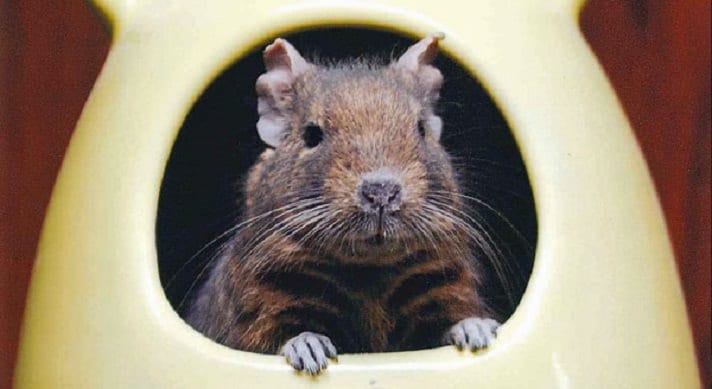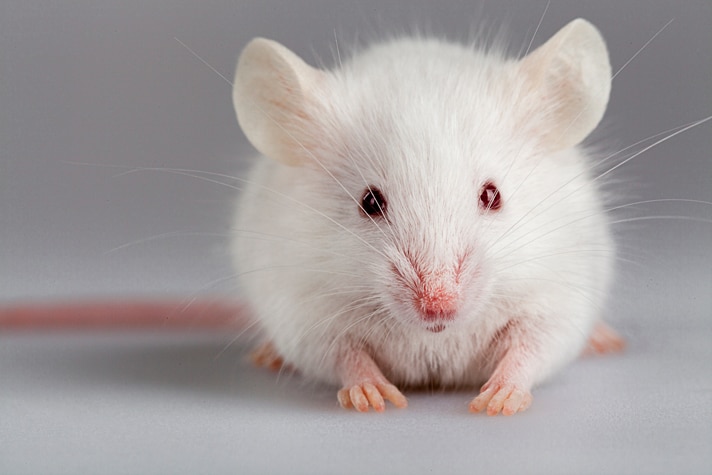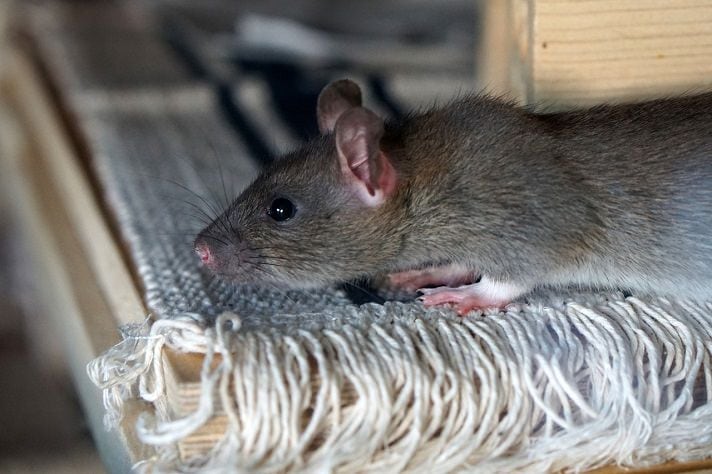Dig a degu? Or perhaps you just haven’t yet heard of this small rodent. This native Chilean is also referred to as the brush-tailed rat, and it resembles a rat but with a hairy tail. In fact, the name degu is reported to mean mouse/rat in the Mapuche language, which is spoken in parts of Chile and Argentina. So what is a degu like as a pet? Check out these degu behaviors.
1. Chewing And Chomping
Like other rodents, degus have an innate need to chew. Their incisor teeth continuously grow, so they need to chew to keep them from overgrowing. Armed with this information, if you keep a degu as a pet, offering appropriate items to chew up is good for his health. It is also good for your home furnishings, especially electrical cords. In fact, don’t even think of allowing your degu to have free-roam in a room without pet-proofing it first, which includes protecting or relocating wires and other cords he might find.
2. Bathing Dust Beauties
Chinchillas aren’t the only pets in town that enjoy a waterless bath. Degus also need dust-bath opportunities, preferably a few times a week. Contrary to what the word suggests, a dust bath doesn’t make the pet dusty and dirty; instead, it helps the degu shake and dislodge bits of dirt and debris from his fur.
3. Hiding Food
To survive winter in their native habitat, degus stash food in their burrows and might also hide some around the ground outside their burrow. Don’t be surprised to see your pet degu bury extra food in his cage/habitat or around your home. And a degu has a habit of checking up on his stash (uncovering it and covering it up again), so paying attention to your degu’s behavior can help you zero in on where hidden food might be, like hidden in your shag rug.
4. They Dig It
In the wild, degus spend part of their day above ground foraging for food. But they also need a place to flee to evade predators and to keep cool on hot days, so they dig tunnels and create burrows. A pet degu will also want to dig a tunnel/create a burrow, so help him feel most at home in your home by offering a rodent-safe bedding material for him to dig and tunnel through. They are diurnal, so expect to see your degu most active in the late evening and early morning hours.
5. Frozen In Fear
A degu is not your typical “fight or flight” animal. A degu that is nervous, cautious or downright afraid might respond by not moving at all in an attempt to blend into the environment instead of bringing attention to himself. If your degu is motionless, try to find the cause of his displeasure or relocate him to a familiar environment, like his cage. [Consider rabbit cages or a guinea pig cage to house your degu.]
6. Peeing With Purpose
A degu marks his territory by urinating on objects and areas within it. In a pet situation, that means that your degu might pee on his bowls, bath, toys and any other item that he deems worthy of his possession. If you have more than one degu, the dominant one will likely pee the most and will even pee on whatever another degu has peed on to show his dominance. Some degu owners put rags in favored areas for their degus to pee on to keep this marking behavior limited to certain locations.
7. Nibble On You
If your degu starts to nibble on you, don’t worry — he’s not being aggressive or worse, trying to eat you! His way of showing affection is by gently nibbling on your skin. In the wild, degus show affection toward each other by grooming one another, so being groomed by your degu is a sign that you’ve made your degu feel right at home in your home and part of the family … or that he enjoyed you petting him for a long stretch of time.
8. Tail Wagging
A degu will tail wag due to hormones — a female might wag/flick her tail to let a male know that she is in breeding mode — and degus also might tail wag or stomp the tail on the ground as a way of posturing/showmanship. Speaking of tails, a degu’s tail can come off if he is grabbed/picked up by his tail and, unlike a lizard, a degu will not regrow a tail. Never pick up your degu by the tail, and be careful when closing his cage door, as this can also cause an injury to the tail.
9. Tests Of Dominance
Degus have a social hierarchy, and if you keep more than one, they might challenge each other for the honor of “top degu.” If you see one degu mount another, which may resemble mating, he might be trying to establish his dominance. If the other degu disagrees, fighting can ensue, so pay attention to your degus interactions and separate them if need be.
10. Many Sounds
Degus are said to have a wide range of sounds. An annoyed degu might chatter his teeth, which sounds like grinding. A rapid succession of squeaks usually signifies that the degu is scared; it is attention-grabbing, so you’ll know to check on your degu if you hear it. Hopefully, you’ll hear your degu make a warbling or chirping sound — this should be music to your ears, as it means that your pet is happy and content.
By: Laura DoeringFeatured Image: Courtesy of Lauren Sherman
Small Pet Behaviors
Share:









